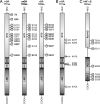Crosstalk in inflammation: the interplay of glucocorticoid receptor-based mechanisms and kinases and phosphatases
- PMID: 19890091
- PMCID: PMC2818158
- DOI: 10.1210/er.2009-0013
Crosstalk in inflammation: the interplay of glucocorticoid receptor-based mechanisms and kinases and phosphatases
Abstract
Glucocorticoids (GCs) are steroidal ligands for the GC receptor (GR), which can function as a ligand-activated transcription factor. These steroidal ligands and derivatives thereof are the first line of treatment in a vast array of inflammatory diseases. However, due to the general surge of side effects associated with long-term use of GCs and the potential problem of GC resistance in some patients, the scientific world continues to search for a better understanding of the GC-mediated antiinflammatory mechanisms. The reversible phosphomodification of various mediators in the inflammatory process plays a key role in modulating and fine-tuning the sensitivity, longevity, and intensity of the inflammatory response. As such, the antiinflammatory GCs can modulate the activity and/or expression of various kinases and phosphatases, thus affecting the signaling efficacy toward the propagation of proinflammatory gene expression and proinflammatory gene mRNA stability. Conversely, phosphorylation of GR can affect GR ligand- and DNA-binding affinity, mobility, and cofactor recruitment, culminating in altered transactivation and transrepression capabilities of GR, and consequently leading to a modified antiinflammatory potential. Recently, new roles for kinases and phosphatases have been described in GR-based antiinflammatory mechanisms. Moreover, kinase inhibitors have become increasingly important as antiinflammatory tools, not only for research but also for therapeutic purposes. In light of these developments, we aim to illuminate the integrated interplay between GR signaling and its correlating kinases and phosphatases in the context of the clinically important combat of inflammation, giving attention to implications on GC-mediated side effects and therapy resistance.
Figures





References
-
- Hench PS, Kendall EC, Slocumb CH 1949 The effect of a hormone of the adrenal cortex (17-hydroxy-11-dehydrocorticosterone; compound E) and of pituitary adrenocorticotropic hormone on rheumatoid arthritis. Mayo Clin Proc 24:181–197 - PubMed
-
- Pascual G, Glass CK 2006 Nuclear receptors versus inflammation: mechanisms of transrepression. Trends Endocrinol Metab 17:321–327 - PubMed
-
- Polito AJ, Proud D 1998 Epithelia cells as regulators of airway inflammation. J Allergy Clin Immunol 102:714–718 - PubMed
Publication types
MeSH terms
Substances
Grants and funding
LinkOut - more resources
Full Text Sources
Other Literature Sources
Medical
Research Materials
Miscellaneous

